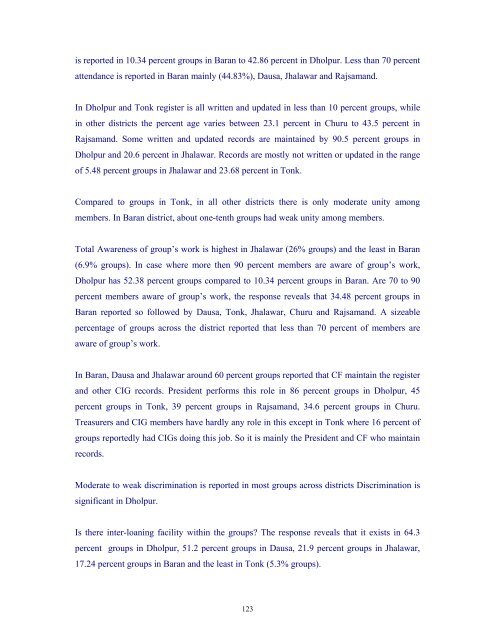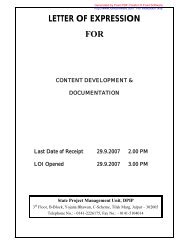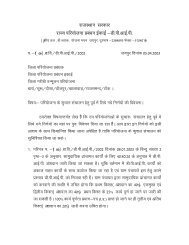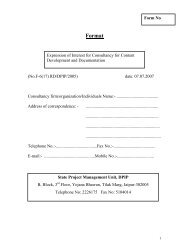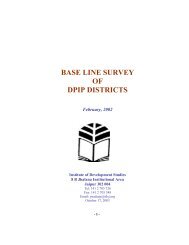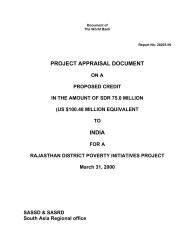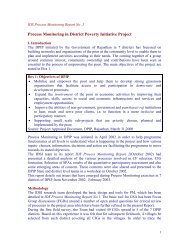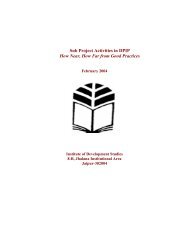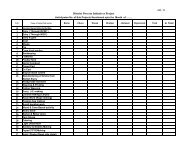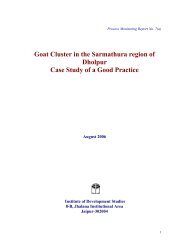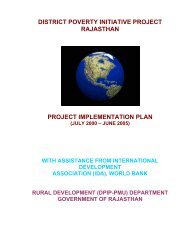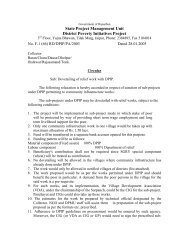Impact Assessment of the District Poverty Initiative Project Rajasthan
Impact Assessment of the District Poverty Initiative Project Rajasthan
Impact Assessment of the District Poverty Initiative Project Rajasthan
You also want an ePaper? Increase the reach of your titles
YUMPU automatically turns print PDFs into web optimized ePapers that Google loves.
is reported in 10.34 percent groups in Baran to 42.86 percent in Dholpur. Less than 70 percent<br />
attendance is reported in Baran mainly (44.83%), Dausa, Jhalawar and Rajsamand.<br />
In Dholpur and Tonk register is all written and updated in less than 10 percent groups, while<br />
in o<strong>the</strong>r districts <strong>the</strong> percent age varies between 23.1 percent in Churu to 43.5 percent in<br />
Rajsamand. Some written and updated records are maintained by 90.5 percent groups in<br />
Dholpur and 20.6 percent in Jhalawar. Records are mostly not written or updated in <strong>the</strong> range<br />
<strong>of</strong> 5.48 percent groups in Jhalawar and 23.68 percent in Tonk.<br />
Compared to groups in Tonk, in all o<strong>the</strong>r districts <strong>the</strong>re is only moderate unity among<br />
members. In Baran district, about one-tenth groups had weak unity among members.<br />
Total Awareness <strong>of</strong> group’s work is highest in Jhalawar (26% groups) and <strong>the</strong> least in Baran<br />
(6.9% groups). In case where more <strong>the</strong>n 90 percent members are aware <strong>of</strong> group’s work,<br />
Dholpur has 52.38 percent groups compared to 10.34 percent groups in Baran. Are 70 to 90<br />
percent members aware <strong>of</strong> group’s work, <strong>the</strong> response reveals that 34.48 percent groups in<br />
Baran reported so followed by Dausa, Tonk, Jhalawar, Churu and Rajsamand. A sizeable<br />
percentage <strong>of</strong> groups across <strong>the</strong> district reported that less than 70 percent <strong>of</strong> members are<br />
aware <strong>of</strong> group’s work.<br />
In Baran, Dausa and Jhalawar around 60 percent groups reported that CF maintain <strong>the</strong> register<br />
and o<strong>the</strong>r CIG records. President performs this role in 86 percent groups in Dholpur, 45<br />
percent groups in Tonk, 39 percent groups in Rajsamand, 34.6 percent groups in Churu.<br />
Treasurers and CIG members have hardly any role in this except in Tonk where 16 percent <strong>of</strong><br />
groups reportedly had CIGs doing this job. So it is mainly <strong>the</strong> President and CF who maintain<br />
records.<br />
Moderate to weak discrimination is reported in most groups across districts Discrimination is<br />
significant in Dholpur.<br />
Is <strong>the</strong>re inter-loaning facility within <strong>the</strong> groups The response reveals that it exists in 64.3<br />
percent groups in Dholpur, 51.2 percent groups in Dausa, 21.9 percent groups in Jhalawar,<br />
17.24 percent groups in Baran and <strong>the</strong> least in Tonk (5.3% groups).<br />
123


